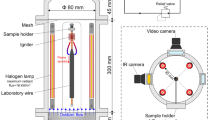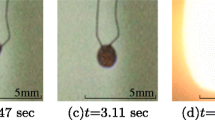Abstract
Fluorinated ethylene propylene (FEP) wire insulation ignition is investigated in a forced flow field in microgravity and normal gravity with a continuous current. First, FEP insulation melts and decomposes, causing jet bursting in both normal gravity and microgravity. Second, the forced flow and gravity produce minor effects on the core heating and bursting time, while the pyrolysis time increases slightly with increasing air velocity. Third, the positively stretch rates in terms of the velocity gradients are higher in microgravity. Both the forced flow and gravity have significant effects on the induction time, which is dependent on the stretch rate and Damköhler number. The induction time increases with increasing air velocity, and it is higher in microgravity. Finally, the ignition delay time is dominated by the core heating and bursting time, while its bigger value and faster increase in microgravity with increasing air velocity are dominated by the induction time.









Similar content being viewed by others
REFERENCES
O. Fujita, “Solid Combustion Research in Microgravity as a Basis of Fire Safety in Space," Proc. Combust. Inst. 35 (3), 2487–2502 (2015).
Y. Nakamura, H. Yamashita, T. Takeno, and G. Kushida, “Effects of Gravity and Ambient Oxygen on a Gas-Phase Ignition over a Heated Solid Fuel," Combust. Flame 120 (1/2), 34–48 (2000).
S. L. Olson, T. Kashiwagi, O. Fujita, et al., “Experimental Observations of Spot Radiative Ignition and Subsequent Three-Dimensional Flame Spread over Thin Cellulose Fuels," Combust. Flame 125 (1/2), 852–864 (2001).
S. McAllister, C. Fernandez-Pello, D. Urban, and G. Ruff, “The Combined Effect of Pressure and Oxygen Concentration on Piloted Ignition of a Solid Combustible," Combust. Flame 157(9), 1753–1759 (2010).
S. L. Olson, “Piloted Ignition Delay Times of Opposed and Concurrent Flame Spread over a Thermally-Thin Fuel in a Forced Convective Microgravity Environment," Proc. Combust. Inst.33 (2), 2633–2639 (2011).
X. Huang, Y. Nakamura, and F. A. Williams, “Ignition-to-Spread Transition of Externally Heated Electrical Wire," Proc. Combust. Inst. 34 (2), 2505–2512 (2013).
Y. Nakamura, N. Yoshimura, H. Ito, et al., “Flame Spread over Electric Wire in Sub-Atmospheric Pressure," Proc. Combust. Inst.32 (2), 2559–2566 (2009).
O. Fujita, T. Kyono, Y. Kido, et al., “Ignition of Electrical Wire Insulation with Short-Term Excess Electric Current in Microgravity," Proc. Combust. Inst. 33 (2), 2617–2623 (2011).
Y. Takano, O. Fujita, N. Shigeta, et al., “Ignition Limits of Short-Term Overloaded Electric Wires in Microgravity," Proc. Combust. Inst. 34 (2), 2665–2673 (2013).
S. Takahashi, H. Takeuchi, H. Ito, et al., “Study on Unsteady Molten Insulation Volume Change during Flame Spreading over Wire Insulation in Microgravity," Proc. Combust. Inst. 34(2), 2657–2664 (2013).
A. F. Osorio, K. Mizutani, C. Fernandez-Pello, and O. Fujita, “Microgravity Flammability Limits of ETFE Insulated Wires Exposed to External Radiation," Proc. Combust. Inst. 35 (3), 2683–2689 (2015).
J. Fang, S. Zhao, J. Wang, et al., “Sub-Atmospheric Bursting Ignition of Fluorinated Ethylene Propylene Wire Insulation," Fire Saf. J. 100, 45–50 (2018).
J. F. Guan, J. Fang, Y. Xue, et al., “Morphology and Concentration of Smoke from Fluorinated Ethylene Propylene Wire Insulation in Microgravity under Forced Airflow," J. Hazard. Mater.320, 602–611 (2016).
L. A. Wall and S. Straus, “Pyrolysis of Fluorocarbon Polymers," J. Res. Natl. Bur. Std. A 65, 227–238 (1961).
C. H. Douglass, H. D. Ladouceur, V. A. Shamamian, and J. R. McDonald, “Combustion Chemistry in Premixed C2F4–O2 Flames," Combust. Flame 100 (4), 529–542 (1995).
G. Cox, Combustion Fundamentals of Fire (Academic Press, London, 1995).
K. Wang, J. Fang, J. W. Wang, et al., “Microgravity Ignition Delay of Fluorinated Ethylene Propylene Wire Insulation in Forced Flow Field," in Proc. of the 9th Int. Seminar on Fire and Explosion Hazards, St. Petersburg, April 21–26, 2019 (St. Petersburg Polytech. Univ. Press, 2019), Vol. 1, pp. 225–235.
S. McAllisteret et al., Fundamentals of Combustion Processes (Springer, New York, 2011).
T. Niioka, “Ignition Time in the Stretched-Flow Field," Symp. (Int.) on Combustion. 18 (1), 1807–1813 (1981).
C. K. Law, Combustion Physics (Cambridge Univ. Press, 2006).
S. R. Turns, An Introduction to Combustion(McGraw-Hill, Boston, 2000).
Author information
Authors and Affiliations
Corresponding author
Rights and permissions
About this article
Cite this article
Wang, K., Fang, J., Wang, JW. et al. Ignition Delay of Fluorinated Ethylene Propylene Wire Insulation in a Forced Flow Field in Microgravity. Combust Explos Shock Waves 56, 412–420 (2020). https://doi.org/10.1134/S0010508220040048
Received:
Published:
Issue Date:
DOI: https://doi.org/10.1134/S0010508220040048




